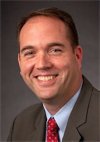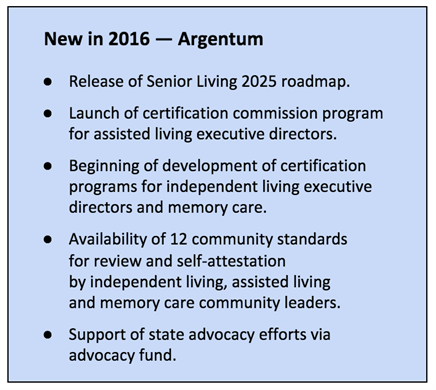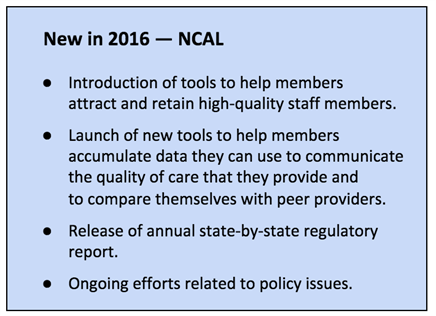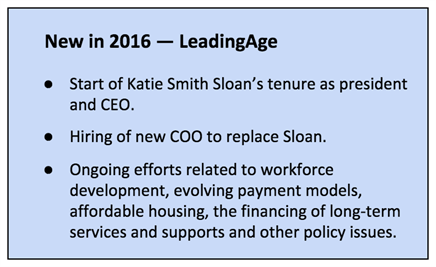
Relatively new leadership at three associations representing senior living providers will be facing established and evolving issues in 2016. Matters related to the workforce, regulation of assisted living, affordable housing and new payment models will be among the top items on their agendas in the new year, they tell McKnight’s Senior Living.
 Workforce issues were the top concerns that members expressed to Argentum President and CEO James Balda and other association leaders on a recently concluded “listening tour,” Balda says. “It was what people wanted to talk about and what people actually couldn’t stop talking about,” he adds. “Operators are starting to feel more and more pressure from a wage perspective. It’s what I would call the Walmart effect, in terms of a lot of their direct care workers may prefer to go across the street and work at Walmart as opposed to what is hard work in terms of providing care for seniors.”
Workforce issues were the top concerns that members expressed to Argentum President and CEO James Balda and other association leaders on a recently concluded “listening tour,” Balda says. “It was what people wanted to talk about and what people actually couldn’t stop talking about,” he adds. “Operators are starting to feel more and more pressure from a wage perspective. It’s what I would call the Walmart effect, in terms of a lot of their direct care workers may prefer to go across the street and work at Walmart as opposed to what is hard work in terms of providing care for seniors.”
The issue is one of quality as well as quantity, says Balda, who will celebrate his first anniversary at the helm of the former Assisted Living Federation of America on Jan. 15, previously having been senior vice president of innovation and business development at the National Restaurant Association. “It’s something folks are concerned about even longer-term, as we’re going to need more workers in the industry,” he says.
Early in 2016, Balda says, an Argentum committee will consider ways that the industry can recruit employees, perhaps through training programs at high schools and community colleges as well as through visa program reforms.
Workforce development, quality care, operational excellence and consumer choice are the four major issues around which Argentum hopes to develop consensus among industry stakeholders. As part of the Senior Living 2025 campaign the organization began in 2015, Balda and other Argentum leaders conducted the six-month listening tour related to those topics, and insights from the member visits have helped create a roadmap to solutions that the association plans to reveal this month.
“The critical piece that will come out of that will be the strategies that the industry needs to focus on, and some of those strategies are things that Argentum will be working on directly—things like workforce development, quality standards and other things,” Balda says. In some areas, Balda says, Argentum will play a supporting role in the work of industry groups. The National Investment Center for Seniors Housing and Care, for instance, is developing operational benchmarks and looking at regulatory roles, he says, and the American Seniors Housing Association is raising consumer awareness of issues of interest to senior living through a campaign.
Argentum also will be busy with its recently announced certification commission and community standards.
The commission will launch its first program, for assisted living community executive directors, in the third quarter of 2016. A beta version of the certification test will be available earlier in the year, and the commission will begin developing certification programs for independent living executive directors and memory care in 2016.
 The 12 standards will be available for review and self-attestation by independent living, assisted living and memory care community leaders in 2016. They will be publicly viewable online this month, at which time Argentum will be seeking feedback.
The 12 standards will be available for review and self-attestation by independent living, assisted living and memory care community leaders in 2016. They will be publicly viewable online this month, at which time Argentum will be seeking feedback.
Supporting state partners in their advocacy efforts also will be a major focus for Argentum in 2016, Balda says. In 2015, the organization concentrated on activities in California, Florida, Texas, Massachusetts and Washington. In 2016, a few more states will be added to the list, he says.
Helping finance the advocacy efforts of state partners will be the industry fund that Argentum launched in late 2015. More than $1 million in corporate contributions has been raised to support government relations activities, legal defense needs and research related to public policy positions, Balda says. The fund is separate from a political action committee that supports election campaigns, he adds.
“Our board felt that we needed this advocacy fund to help us start to shift the regulatory framework in the states in a way that is positive and protects us, potentially, long-term, from any kind of federal oversight,” Balda says.
Maintaining regulation of assisted living at the state level also is a priority for the National Center for Assisted Living, NCAL Executive Director Scott Tittle tells McKnight’s Senior Living.
 “We believe, because of the unique characteristics of assisted living residents, that the state regulatory process in place needs to be maintained,” says Tittle, who has been in his role for about six months after having been state executive for the Indiana Health Care Association. NCAL plans to release its annual state-by-state regulatory report in mid-2016, he says, adding that the report was not published in 2015 due to the timing of the release of a report by the U.S. Department of Health and Human Services’ Office of Assistant Secretary for Planning and Evaluation.
“We believe, because of the unique characteristics of assisted living residents, that the state regulatory process in place needs to be maintained,” says Tittle, who has been in his role for about six months after having been state executive for the Indiana Health Care Association. NCAL plans to release its annual state-by-state regulatory report in mid-2016, he says, adding that the report was not published in 2015 due to the timing of the release of a report by the U.S. Department of Health and Human Services’ Office of Assistant Secretary for Planning and Evaluation.
NCAL also will be announcing new tools for members in 2016, Tittle says. Some of the new tools and education will be designed to help members attract and retain high-quality staff members — NCAL, too, has identified meeting future workforce needs as a major issue facing assisted living.
Other new tools will help members accumulate data they can use to communicate the quality of care that they provide and to compare themselves with peer providers, Tittle says. “As more and more people become more interested in what assisted living is, whether it be payers or policy leaders or the press or residents and families, people are continuously wanting to know how assisted living is measured in terms of quality outcomes,” he says. The new tools will add to the LTC Trend Tracker and Quality Awards efforts already available to members, Tittle adds.
NCAL also will be keeping an eye on several policy issues, including four Senators’ July request of the Government Accountability Office to review Medicaid spending in assisted living. Tittle thinks the process will be a lengthy one, as the government is focused on other issues for now.
Another issue the organization is watching involves state and federal plans for home- and community-based services waivers for Medicaid beneficiaries. In advance of the 2019 compliance date for the final rule issued by the Centers for Medicare and Medicaid Services in January 2014, states have submitted plans explaining how they will transition to a new system and, if requested, additional details, to CMS. “We’ve been working with our state affiliate chapters very closely to ensure that member and provider interests are being represented as part of those processes,” Tittle says.
 “There certainly is a significant concern that, if applied as strictly as the rule reads and as some state transition plans are set forth, in some cases there could be assisted living providers that would be considered taking on characteristics of institutions under the rule and thus [would be] ineligible for Medicaid or waiver or state plan services reimbursement going forward,” Tittle continues. “There certainly is a concern that, in some cases, there would be fewer choices for residents and consumers in the marketplace, which, quite honestly, could very well lead to larger Medicaid costs as well, because then the only options that a family member would have would be a higher-cost setting like a nursing home.”
“There certainly is a significant concern that, if applied as strictly as the rule reads and as some state transition plans are set forth, in some cases there could be assisted living providers that would be considered taking on characteristics of institutions under the rule and thus [would be] ineligible for Medicaid or waiver or state plan services reimbursement going forward,” Tittle continues. “There certainly is a concern that, in some cases, there would be fewer choices for residents and consumers in the marketplace, which, quite honestly, could very well lead to larger Medicaid costs as well, because then the only options that a family member would have would be a higher-cost setting like a nursing home.”
NCAL also continues to study states that are in various stages of adopting a managed care approach for Medicaid beneficiaries, Tittle says. “States are grappling with, what are the true benefits of managed care other than the purported savings?” he says, adding that studies he has reviewed haven’t shown “dramatic cost savings and at the same time dramatic quality improvement.” Nonetheless, Tittle says, managed care is part of the evolving reimbursement environment that includes accountable care organizations and other changes.
LeadingAge members also are confronting “the changing nature of payment models and how they fit in, how they negotiate, how they tell their story, how they become part of the solution in their state or their community or their region, depending on how things are being structured. There’s so much in flux,” Katie Smith Sloan tells McKnight’s Senior Living. She began the new year in her new role as the president and CEO of the organization after having been chief operating officer since 2002.
 LeadingAge is providing payment model-related technical assistance to members where needed, Sloan says. “There’s a lot of conversation about the best ways for members to engage, whether it’s ACOs or bundled payments or creating a network to negotiate with health plans,” she says. “We’ve been helping as we can so that our members can put their best foot forward and be part of the solution as it unfolds in states.”
LeadingAge is providing payment model-related technical assistance to members where needed, Sloan says. “There’s a lot of conversation about the best ways for members to engage, whether it’s ACOs or bundled payments or creating a network to negotiate with health plans,” she says. “We’ve been helping as we can so that our members can put their best foot forward and be part of the solution as it unfolds in states.”
On the affordable housing front, Sloan says, seniors in need are facing long waiting lists to enter member properties. “The units are not turning over,” she says. “There’s a real shortage there.” LeadingAge is working with members of Congress to ensure sufficient funding and tax credits for new development, Sloan says. “There’s no one solution to this problem, so we’re moving on multiple fronts.”
The organization continues to identify and evaluate models of affordable housing with services, she adds. “We did a project funded through the AARP Foundation this past year looking at how health plans can get involved … and we’ll continue that work. It shows great promise, and it’s desperately needed to bring services to those residents in affordable housing.”
 LeadingAge also continues to seek ways to encourage members of the public to save for their future long-term services and supports needs in the wake of the November publication of research in Health Affairs that looked at possible models for doing so. Legislative solutions stemming from the Urban Institute research, which was funded by LeadingAge, the AARP and the SCAN Foundation, are “on the long-term horizon,” Sloan says. “We have a lot more thinking to do about what’s plausible and what makes sense, both given the political environment and the realities of the marketplace,” she says.
LeadingAge also continues to seek ways to encourage members of the public to save for their future long-term services and supports needs in the wake of the November publication of research in Health Affairs that looked at possible models for doing so. Legislative solutions stemming from the Urban Institute research, which was funded by LeadingAge, the AARP and the SCAN Foundation, are “on the long-term horizon,” Sloan says. “We have a lot more thinking to do about what’s plausible and what makes sense, both given the political environment and the realities of the marketplace,” she says.
The association also will begin to look for a successor to Sloan as COO soon, with the goal of having someone in the position in the first quarter.
Which brings us back to workforce development. Like Argentum and NCAL members, LeadingAge members also face issues recruiting and retaining qualified workers, Sloan says. The challenges can vary geographically, she adds. “For example, Minnesota members are telling me it’s the lure of the oil fields in North Dakota,” Sloan says. “That’s not even necessarily in our field, so I think we have some work to do to come up with more effective strategies for attracting people to our field.”
No doubt it’s going to be a busy year for senior living.
From the February 01, 2016 Issue of McKnight's Senior Living



